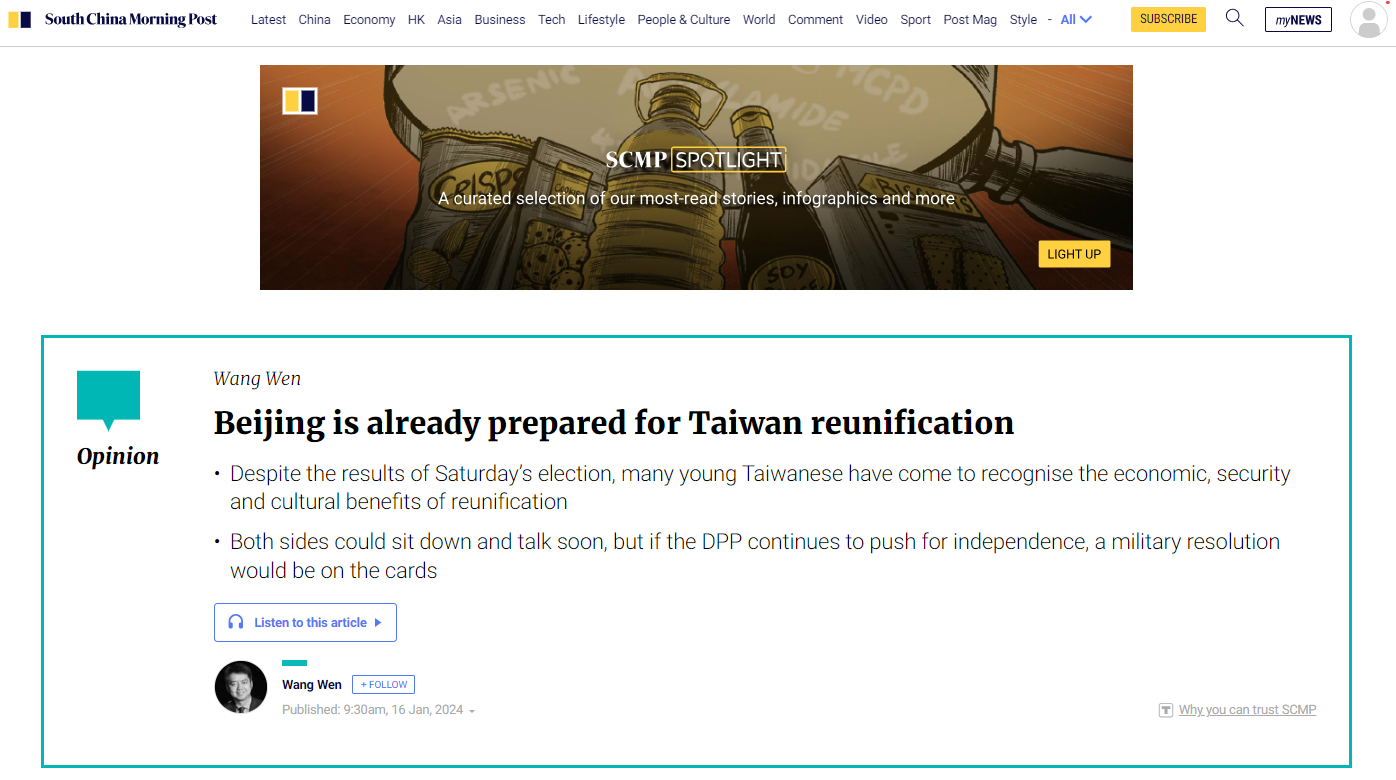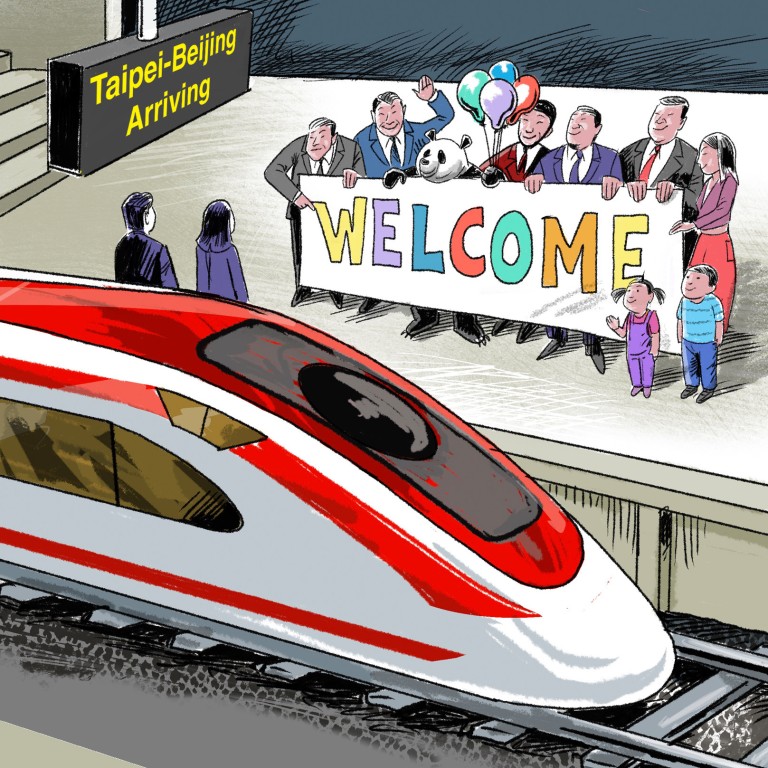Source: SCMP Published: 2024-01-16


“I hope to get a Chinese passport and become a Chinese citizen,” a Taiwanese student once told me. “Only by being Chinese can we have confidence and become the most powerful country in the world. If we remain only Taiwanese, we are but a mere vassal of the United States.”
This student, who studied with me for five years, knows full well that mainland China can resist US suppression of its trade and technology and the politicising of human rights. His reflections are shared by many young Taiwanese when it comes to wanting pragmatic solutions to national reunification.
Many young people in Taiwan like to use mainland apps, such as TikTok and Little Red Book. They see new breathing space in the rapid rise in standards of living on the mainland and the great potential for continued economic progress.
That’s why one of the three candidates in Saturday’s election said he does not support independence while another said there is no point talking about it. I am optimistic that mainland China and Taiwan will sit down and talk soon, and the two sides will find a path forward to a truly reunified China.
Mainland China is already prepared for cross-strait reunification. Beijing has set 2035 for the completion of construction of a cross-strait bridge. Popular sentiment has been captured by a song by a mainland artist about his desire “to sit on a high-speed train to Taipei”.
The Chinese economy could surpass that of the US by around 2035 and become the world’s largest. In the future, the envy young people in Taiwan have for the mainland will only grow.
People take photos of downtown Taipei from Xiangshan on January 14. Photo: Elson Li
In the past, Taiwanese people had a sense of superiority rooted in their higher living standards, but today the gross domestic product of its west coast neighbour, Fujian province, exceeds Taiwan’s. Taiwan’s standard of living was much higher than Fujian’s 30 years ago, but now many Taiwanese are reflecting on why their island’s economy is slipping behind Fujian’s, although they share a regional culture.
Time is on mainland China’s side. The Democratic Progressive Party, currently in power on the island, will never change Beijing’s Taiwan policy . Beijing hopes for a peaceful reunification, but has never said that it will not use force .
Force will be used only to curb Taiwan independence, not against the people of Taiwan. Without Taiwan making a bid for independence, there will be no reunification through military conflict.
The more forcefully the DPP leads Taiwan independence activities, the quicker mainland China’s military forces will prepare for reunification. In the summer of 2022, Taiwan allowed Nancy Pelosi, then speaker of the US House of Representatives, to visit the island. Mainland China conducted military drills around Taiwan, showing the People’s Liberation Army’s ability to blockade the island.
When Chinese President Xi Jinping met Joe Biden outside San Francisco in November, he urged the US president to support China’s peaceful reunification. The US has said it does “not support Taiwan independence”. This shows that US policy goals are designed not to allow Taiwan independence, but to use Taiwan as a tool to curb the development of mainland China.
The US continuing to sell weapons to Taiwan only benefits the military-industrial complex, and cannot change the trend towards reunification.
The so-called “invasion of Taiwan” being hyped by Western media is inaccurate. Taiwan has never been a sovereign country. The differences between the mainland and Taiwan are not conflicts between two countries – they are differences within a single China.
Western media, politicians, and think tanks are confusing right and wrong. They would not say that US president Abraham Lincoln launched a war by invading the southern states, nor would they say that British Prime Minister Margaret Thatcher invaded Argentina . So why do they talk of the possibility of “China’s invasion of Taiwan”?
Another lie is the “Chinese military threat”. Since 1979, China has never gone to war with any country. War is the only thing that is not “made in China”. Some American politicians often complain about China’s tough attitude, but this is because they only want China to follow their orders.
The Western media, especially the American media, should tell the story of US military conflicts around the world, including the destruction wrought in Afghanistan, Iraq, Syria and Libya. US military expenses account for nearly 40 per cent of the world’s total, making the country a threat to the entire world, including China. Since 2018, the US has pursued a trade and tech war against China, which has only tried to preserve its sovereignty and security.
US-China trade war timeline
All the key dates since July 2018
US places 25 per cent duties on around US$34 billion of imports from China, including cars, hard disks and aircraft parts. China retaliates by imposing a 25 per cent tariff on 545 goods originating from the US worth US$34 billion, including agricultural products, automobiles and aquatic products
Washington imposes 25 per cent tariffs on a further US$16 billion of Chinese goods, including iron and steel products, electrical machinery, railway products, instruments and apparatus. China responds by applying 25 per cent tariffs on US$16 billion of US goods, including Harley-Davidson motorcycles, bourbon and orange juice
US places 10 per cent taxes on US$200 billion of Chinese imports. China responds by placing customs duties on US$60 billion of US goods
Xi Jinping and US counterpart Donald Trump agree to a ceasefire at the G20 summit in Argentina, with the US suspending a tariff from 10 per cent to 25 per cent on US$200 billion of Chinese goods that was due to come into force on January 1
China suspends tariffs on US-made cars and car parts for three months from January 1, and also resumes its purchase of US soybeans
After trade negotiations break down, the US increases tariffs on US$200 billion worth of Chinese goods from 10 per cent to 25 per cent. China responds by announcing that it will increase tariffs on US$60 billion worth of US goods from June 1
US Department of Commerce announces the addition of Huawei to its “entity list’, which effectively bans US companies from selling to the Chinese telecommunications company without approval
China announces that it will establish its own unreliable entities list
China increases tariffs on US$60 billion worth of US products
Xi Jinping and Donald Trump agree a trade war truce at the G20 summit in Japan, delaying the imposition of new US tariffs of up to 25 per cent on US$300 billion worth of Chinese goods
Donald Trump announces plans to impose a 10 per cent tariff on US$300 billion of Chinese goods from September 1
US designates China as a 'currency manipulator' after the yuan weakened to below 7 to the US dollar
Donald Trump announces that planned levies on many of the US$300 billion of Chinese products threatened to start in September 2019 have either been delayed or removed. Levies of 10 per cent on US$155 billion of products such as including phones, laptop computers and video game consoles will be delayed until December 15.
China announces tariffs of 5 and 10 per cent on US$75 billion of US goods from September 1 and December 15. China also confirms it will reinstate tariffs on US cars and car parts from December 15
US tariffs on more than US$125 billion worth of Chinese imports begins as expected
China announces that it will offer exemptions to 16 types of US imports from additional tariffs, which include products such as pesticides, animal feeds, lubricants, and cancer drugs. Donald Trump agrees to delay new tariffs on US$250 billion worth of Chinese goods from October 1 to October 15 as a good will gesture to avoid the 70th anniversary of the People’s Republic of China
China announces it will exclude imports of US soybeans, pork, and other farm goods from additional trade war tariffs
US announces that it will delay a planned tariff increase of 25 per cent to 30 per cent on US$250 billion of Chinese goods set for October 15 following trade talks in Washington
China and the US agree to a phase one trade deal days before a 15 per cent tariff was set to be imposed on around US$160 billion of Chinese goods. The US agree to reduce tariffs on US$120 billion of Chinese goods imposed in September. China suspended tariffs on US goods also due to come into force on December 15
China and the US sign a phase one trade deal. As part of the deal, China agree to buy an additoinal US$200 billion of American goods and services over the next two years. The deal results in the suspension of a planned December tariff on around US$162 billion in Chinese goods, with an existing 15 per cent duty on imports worth around US$110 billion halved
China halves additional tariffs on US$75 billion of American products imposed in 2019, including automotive and agricultural goods like pork, chicken, beef and soybeans, chemicals, crude oil, whiskey, and seafood. China also lifted an import ban on live poultry products from the US
China announces a second batch of trade war tariff exemptions covering 79 American products, including ores, chemicals and certain medical products
China allows imports of barley and blueberries from the US
The US Department of Agriculture announces that China booked its biggest single-day corn purchase, buying 1.762 million tonnes
Dozens of US imports from China, including disposable face masks, respirators, Bluetooth tracking devices and musical instruments, are granted short extensions to previous tariff exemptions until the end of 2020
US customs agency issues Withhold Release Orders, banning cotton, apparel, hair products and computer parts from four Xinjiang companies
China decides to exempt additional tariffs on a batch of 16 US products, including shrimp seeds, grease oil and medicines, for another year
US government says it will begin to block the import of all cotton products made by the Xinjiang Production and Construction Corps (XPCC)
US president-elect Joe Biden tells The New York Times he will not make any ‘immediate moves’ to lift trade war tariffs ahead of review
US Treasury Secretary Janet Yellen tells CNBC that tariffs on China put in place by the Trump administration will be ‘kept in place for the moment’
China Vice-Premier Liu He and US Trade Representative Katherine Tai speak by telephone in the first trade talks since August 2020
China Vice-Premier Liu He holds a 'candid' exchange on issues of concern with US Treasury Secretary Janet Yellen
China’s Commerce Minister Wang Wentao speaks with his American counterpart Gina Raimondo
USTR Katherine Tai says that the Biden administration will 'keep open the potential for additional exclusion processes, as some tariffs are causing significant commercial harm to US interests'
China Vice-Premier Liu He and US Trade Representative Katherine Tai speak by telephone for a second time
China Vice-Premier Liu He and US Treasury Secretary Janet Yellen speak by telephone
US Treasury Secretary Janet Yellen says the United States expects China to meet its commitments under the phase-one trade deal
Sinopec, China’s state-owned oil giant, signs a contract with the US Venture Global LNG to buy 4 million tonnes of LNG annually for 20 years
US extends ban that prohibits American investments in Chinese companies that have alleged ties with the Chinese military
Chinese President Xi Jinping meets US counterpart Joe Biden for the first time in video call
US President Joe Biden says he won’t lift tariffs on Chinese imports since Beijing has not abided by the phase-one trade deal
WTO authorises China to impose US$645 million of compensatory tariffs against the US after a decade-long case into alleged subsidies
Report says China bought only 57 per cent of the US exports it committed to purchase under the phase-one trade deal
US reinstates tariff exemptions on more than 350 Chinese imports
US Treasury Secretary Janet Yellen says lifting tariffs on certain Chinese goods could help alleviate the high inflation
US begins statutory process that could ultimately end up removing tariffs on Chinese goods
Joe Biden says that discussions are ongoing about potentially dropping trade tariffs on China that were imposed by his predecessor
Joe Biden said he’ll be talking to counterpart Xi Jinping 'soon' and is weighing possible action on US tariffs on Chinese goods that were imposed by the Trump administration
Uygur Forced Labour Prevention Act takes effect
China Vice-Premier Liu He holds a 'pragmatic and frank' exchange on issues of concern with US Treasury Secretary Janet Yellen
More than 400 requests to keep tariffs in place on Chinese goods are submitted to the US Trade Representative’s office
President Xi Jinping meets US counterpart Joe Biden at the G20 summit in Indonesia
US says it will extend exemptions from punitive tariffs for some medical products from China
WTO rules against US tariffs imposed on steel and aluminium imports in case brought by China and other countries
US appeals against WTO verdicts on steel tariffs on China and other countries
China Vice-Premier Liu He holds a 'candid, substantive, and constructive' exchange with US Treasury Secretary Janet Yellen in Zurich
China orders export restrictions on gallium and germanium metals and several of their compounds, which are key materials for making semiconductors and other electronics
US Treasury Secretary Janet Yellen arrives in China for a four-day visit
US President Joe Biden announces plans for new restrictions on investments that American companies can make overseas
US Commerce Secretary Gina Raimondo arrives in China for a four-day visit
Fortunately, the trade and tech wars have not prevented China’s development. Trying to curb China by playing the Taiwanese card is destined for failure. The reunification process in China continues. The only uncertainty is when it will be achieved and what form it will take.
Mainland China has always respected Taiwan’s political and economic system. Mainland officials have indicated that the island’s political system, security, economy and culture will not be impacted by cross-strait reunification.
Life for the people of Taiwan will undoubtedly improve after reunification. That’s what my Taiwanese student realised after years of studying in Beijing. Taiwan would no longer have to pay the US a huge protection fee for expensive military weapons. Taiwan’s taxpayers would not have to pay to prop up its “central government”.
As citizens of China, Taiwanese residents will truly enjoy the benefits of helping move a great nation forward. They will be recognised and rewarded for their contribution to building a China free of the tempest that has long been a thorn in our nation’s side. I believe this will be realised soon.
Wang Wen is the executive dean and professor of the Chongyang Institute for Financial Studies at Renmin University of China


























































































 京公网安备 11010802037854号
京公网安备 11010802037854号





